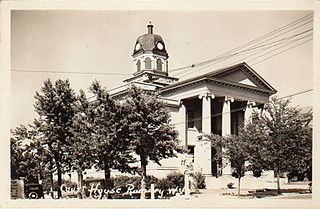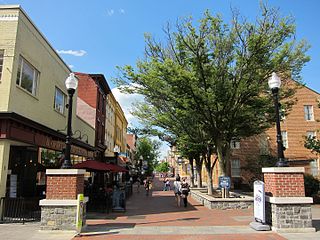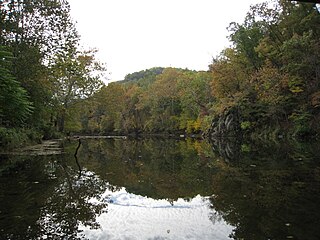| Spring Gap Mountain | |
|---|---|
| Highest point | |
| Elevation | 2,237 ft (682 m) [1] |
| Coordinates | 39°27′27″N78°28′53″W / 39.4575955°N 78.4813996°W Coordinates: 39°27′27″N78°28′53″W / 39.4575955°N 78.4813996°W [2] |
| Geography | |
| Location | Hampshire / Morgan counties, West Virginia, U.S. |
| Parent range | Ridge-and-Valley Appalachians or Allegheny Mountains |
| Topo map | USGS Largent, Levels |
| Climbing | |
| Easiest route | Hike |
Spring Gap Mountain runs southwest northeast through Morgan and Hampshire counties in West Virginia's Eastern Panhandle, rising to its greatest elevation of 2,237 ft (682 m) north of "Spring Gap", from which the mountain takes its name. The gap is the source for Dug Hill Run, a tributary stream of the Little Cacapon River.

Morgan County is a county located in the U.S. state of West Virginia. As of the 2010 census, the population was 17,541. Its county seat is Berkeley Springs. The county was formed in 1820 from parts of Hampshire and Berkeley Counties and named in honor of General Daniel Morgan, prominent soldier of the American Revolutionary War.

Hampshire County is a county in the U.S. state of West Virginia. As of the 2010 census, the population was 23,964. Its county seat is Romney, West Virginia's oldest town (1762). The county was created by the Virginia General Assembly in 1754, from parts of Frederick and Augusta Counties (Virginia) and is the state's oldest county. The county lies in both West Virginia's Eastern Panhandle and Potomac Highlands regions.

West Virginia is a state located in the Appalachian region in the Southern United States and is also considered to be a part of the Middle Atlantic States. It is bordered by Pennsylvania to the north, Maryland to the east and northeast, Virginia to the southeast, Kentucky to the southwest, and Ohio to the northwest. West Virginia is the 41st largest state by area, and is ranked 38th in population. The capital and largest city is Charleston.
Spring Gap Mountain is a mountain ridge with its southern point rising north of Slanesville between Noland Ridge 1,161 ft (354 m) and Sideling Hill. North of Spring Gap, the mountain reaches its highest peak and continues northeast with the Little Cacapon River meandering by Neals Run along its western flank. The northern end of Spring Gap Mountain is located south of West Virginia Route 9 southeast of Paw Paw.

A mountain is a large landform that rises above the surrounding land in a limited area, usually in the form of a peak. A mountain is generally steeper than a hill. Mountains are formed through tectonic forces or volcanism. These forces can locally raise the surface of the earth. Mountains erode slowly through the action of rivers, weather conditions, and glaciers. A few mountains are isolated summits, but most occur in huge mountain ranges.

A ridge or a mountain ridge is a geological feature consisting of a chain of mountains or hills that form a continuous elevated crest for some distance. The sides of the ridge slope away from narrow top on either side.The line along the crest formed by the highest points, with the terrain dropping down on either side, is called the ridgeline. Ridges are usually termed hills or mountains as well, depending on size.

Slanesville is an unincorporated community in northeastern Hampshire County in the U.S. state of West Virginia. Slanesville is located at the crossroads of Bloomery Pike with Slanesville Pike and Cold Stream Road. Slanesville Pike and Cold Stream Road formerly made up the Springfield Grade Road that ran from Capon Bridge to Springfield. According to the 2000 census, the Slanesville community has a population of 691.
During the French and Indian War (1754–1763), Major General Edward Braddock's march from Winchester, Virginia to Cumberland, Maryland took him and his men across Spring Gap Mountain. Braddock and his men camped atop Spring Gap Mountain because of the abundance of fresh drinking water at the mountain's "Spring Gap." From the mountain, Braddock and his men traveled downhill to the Little Cacapon River, which they followed to Fort Cox on the Potomac River.

The French and Indian War (1754–1763) pitted the colonies of British America against those of New France, each side supported by military units from the parent country and by American Indian allies. At the start of the war, the French colonies had a population of roughly 60,000 settlers, compared with 2 million in the British colonies. The outnumbered French particularly depended on the Indians.

Major General Edward Braddock was a British officer and commander-in-chief for the Thirteen Colonies during the actions at the start of the French and Indian War (1754–1763), which is also known in Europe and Canada as the Seven Years' War (1756–1763). He is generally best remembered for his command of a disastrous expedition against the French-occupied Ohio River Valley in 1755, in which he lost his life.

Winchester is an independent city located in the northwestern portion of the Commonwealth of Virginia in the United States. As of the 2010 census, the population was 26,203. As of 2015, its population is an estimated 27,284. It is the county seat of Frederick County, although the two are separate jurisdictions. The Bureau of Economic Analysis combines the city of Winchester with surrounding Frederick County for statistical purposes.








